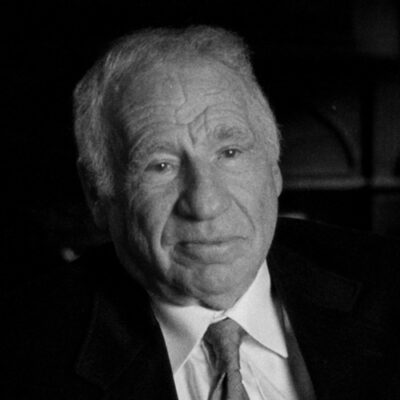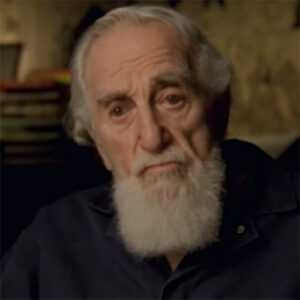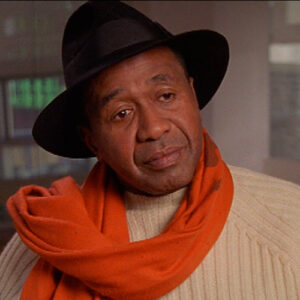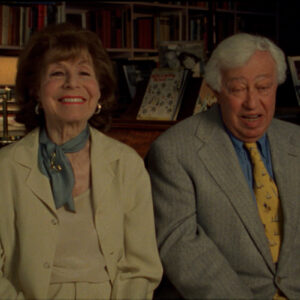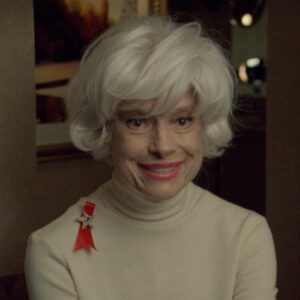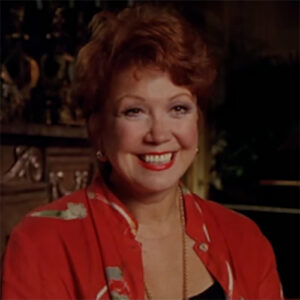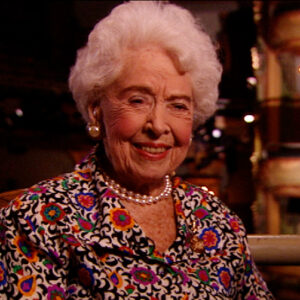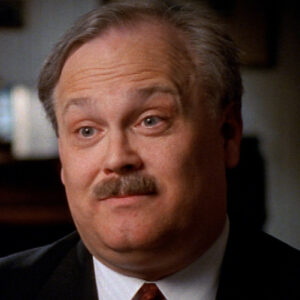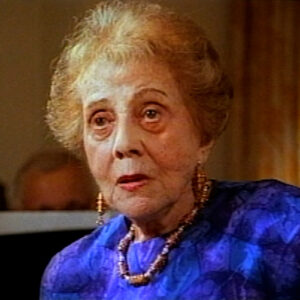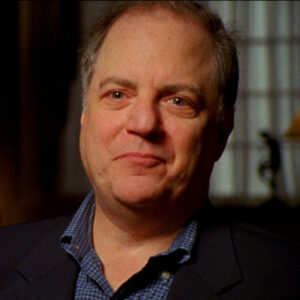Michael Kantor: Broad overview, who are the Schubert brothers, and how important are they in the history of the Broadway musical? Again, this series is just musical, so think music, not both sides of the street.
Gerald Schoenfeld: Well, the Schubert brothers were three poor, impoverished kids from Syracuse who had an affinity for the theater. Two, as far as I know, never had any formal schooling. J.J. Schupert, one of the brothers, went to a parochial school to the eighth grade. The man who started it all, the brother Sam, he was a treasurer of the theater in Syracus. And worked in the box office at the age of 12. Became the manager of the theater. Came to New York when he was 21, in 1900. Joined by his brother Lee, who also worked in a theater in Syracuse and rolled cigars in a window of a store there. Joined his brother Sam, and followed a year later by the youngest brother’s JJ. Organization called the Syndicate at that time, which controlled the American theater. And of course, they didn’t want Schubert getting involved in the business, but Sam Schuvert, with the help of people in Syracuse, financed it, got a toehold in New York, and acquired more backers and more theaters. And in 1905, unfortunately, he was killed in a train wreck. However, his brothers, Lee and J.J., continued on, mainly at their mother’s urging. They really were not friendly with each other. As a matter of fact, they didn’t talk to each other throughout most of their lives. And they went on to basically crush the syndicate. And in their payday, they owned and operated 104 theaters throughout the United States and booked attractions into 1,000 theaters throughout the US. And of course, ultimately, that led to a government anti-trust case against them in 1950. By 1950, they were pretty old men, and Lee Schubert died in 1953, J.J. In 1963. If not for them, there would be no American theater today as we know it. A major corporation of theirs went bankrupt and a lot of the theaters that they had owned were ultimately demolished because they did not buy them back as they did a number of other theaters they bought back. But they paid all of the bondholders of the bankrupt corporation in full and survived the depression. Really by using tax monies. Which they should not have done, and kept the American theater alive.
Michael Kantor: Give me one overarching, you know, you did a little bit of that, but you really can’t, you can’t tell the story of the Broadway musical without these guys because not only did they own theaters, but they were producing shows.
Gerald Schoenfeld: J.J. Schubert, really, was the brother that was involved in musical theater. Lee Schupert more the straight play. J. J. Had an eye, I guess, and an ear, and a number of the shows, the musical shows that they produced, like the Student Prince and Blossom Time and others, originated in Europe, where J.J. Would see them and then have them redone for America. One of the main people that was responsible for the Schubert musicals in those years was Sigmund Romburg. And Sigmung Romburgh was the song man of that period. J.J. Schuberg found him playing the piano in a cafe. And he became a great songwriter for Schupert musicals. They also, emulating Ziegfeld, created their own views called… Passing show and introduced many of the great stars in the musical theater. Eddie Cantor and Mae West and oh, Marilyn Miller. I think that they probably introduced more people into show business than anyone else. Cary Grant brought Sarah Bernhardt to America, the And of course, their greatest star was Al Jolson. Who played in minstrel shows in vaudeville and was discovered by J.J. Schubert. And although they always read in the playbills, the messes Schuvert present, it was really J. J. Schubert who was the main man behind the musicals. And Lee, on the other hand, was the man behind the dramas.
Michael Kantor: That’s great. Really great. Let’s pick up with Al Jolson. Who was Al Jollson? Paint a picture of him and again describe his connection to the Schubert.
Gerald Schoenfeld: Well, Al Jolson was, as I say, a minstrel show performer in Blackface, in the Blackface musicals of the day, the minstrels shows, dock status musicals. And Al Jollson was seen by J.J. Schubert. And J. J. Schuvert put him in a musical show. And from, I guess, until about the… About 1927 he was in the biggest musical shows of that period of time from about 1911 or 12 until then. Al Jolson also used to perform in the Winter Garden Theater and there was a runway from the stage to the rear of the orchestra and he used to performed on that runway on those Sunday night performances. And he was the biggest biggest name in the American musical theater, and probably if people were still alive today who were there in that period, he would probably be a strong contender for the greatest performer in the America musical theater in the 20th century. There was no one like him. And he had a special relationship with J. J. Schubert, not with Lee Schupert. And They were very friendly, as friendly as anyone could be with Jolson or as friendly as anyone can be with JJ Schubert, which is probably more difficult. But when Talking Motion Pictures came into being, Jolton left Schuvert to make the first Talking Motion Picture called The Jazz Singer. And of course, that was regarded by JJ Schubed as the ultimate betrayal because they built to see it. On 59th Street, Central Park South, called the Jolson Theater, which they later changed to the name Century Theater. I don’t know whether that was in retaliation or not, but really his home was the Winter Garden.
Michael Kantor: Can you build a theater in New York anymore and take that back to the 20s when a performer
Gerald Schoenfeld: Schubert’s built many theaters and named them for stars from the beginning, not like now, when they’re named in a sense posthumously. The Ethel Barrymore was named after the great star of that period. Maxine Elliott was another great star and a theater was named after her. And of course, Jolson, as I said. But today, you cannot build a theater and expect to get a return on your investment. Costs are simply too high. There is no government subsidy of any kind to build a theater. The only kind of subsidy that did exist was during the Lindsay years, the mayor of the city of New York at that time, who had the zoning resolution of the City changed to give the builder the opportunity to build the bigger building if it incorporated a theater, That’s why you have the Gershwin Theater. Today, which was originally called the Eurus, and you have the Minskoff Theater today, and the Marriott Marquis, which is built after Lindsay, also though all three built with some form of subsidy. Today, even with the subsidy, you would have a difficult time justifying building a theater, and the only way probably that you could do it is if You had very low interest loans. Loans, and the zoning bonuses that I talked to you about. So we are left, basically, with a stock of existing theaters. And the new ones that exist in this country, that are on campuses of major colleges, were built because the budget had an education line on it, not a cultural line on. And consequently, you have theaters in America, which are magnificent, but are located in remote areas and do not present the kind of attractions that are presented in major markets of this country. But they have the facilities there.
Michael Kantor: But there’s something about those wonderfully ornate, you know, theaters of the 20s. Just sum up again that, you now, the theaters that were built that you’re talking about, the Minskov, the Gershwin, they’re a different kind of barn, a different building. And if you could speak to the fact that, you know Broadway isn’t likely to build any more theaters the way they used to, that would be great.
Gerald Schoenfeld: Well first of all they can’t build any theaters the way they used to since the building code under which they were built no longer exists today. Today you are required to have greater distances between rows and wider seats and many other amenities that simply did not exist in those period. It’s interesting also that the science of acoustics really did not exists in any degree in that period, and yet these are… Perfectly sounding theaters. But the ornate nature of these theaters, you don’t have the artisans to do that work today and if you did, that would add to an already prohibitive cost. So these theaters are now landmark, certainly in New York. It’s deplorable that the Schubert Theater in Los Angeles, one of the great theaters of America was allowed to be demolished for an office building without one note of protest from the Los Angeles community. And you have today a number of municipal auditoriums that are used as theaters. But these landmark palaces, for the most part, are either economically obsolete or obsolescent. So that the only recourse… That an owner of a venue has today is to raise ticket prices in order to compensate for increased costs. We don’t have skyboxes, and we don’t have parking facilities, and don’t have billboard advertising. And we don’t have an opportunity to film our shows because it doesn’t transfer from a two-dimensional surface, two-way two-dimensional surface, really. Three-dimensional stage. So the revenue that the theater venue operator has is from the four walls of that theater. And the revenue that that operator can get would not even begin to pay the debt service on the cost of building a new theater. If you say that the cost of building musical theater today will be in the neighborhood of sixty to seventy million dollars plus land anywhere near that, a small fraction of that cost. So the likelihood of recovering the cost of building a new musical theater doesn’t exist. And it’s, in a sense, ironical that today, A billionaire would like to have a new stadium. A municipality would help finance the building of that stadium, or they would spare special laws, for instance, skyboxes, giving a certain amount of deductibility for the building skybox. But we live now in an era where sports and sports Mania. Is the norm, and culture and theater is not. We have an educational system that is depriving people of a cultural education. So with the values having changed, and of course with the advent first of the talking motion picture, and then television, and then. And now satellite. It’s a very, very different world. It’s interesting to me, by the way. When motion pictures came into existence, theater was the American form of entertainment. And when the talking motion picture came into existence, Schubert could have been a very big player. Lee Schuvert was on the board of Lowe’s. They had their own studio in New Jersey, in Fort Lee, New Jersey. But they never thought that theater would be replaced. Did not seek to get involved in the motion picture business. And motion pictures, when television came along, instead of their co-opting television, they fought it. And of course, are in the position now of being affected by television. And when cable came along television fought cable. So now cable is impacting television. And now of course with satellite and direct broadcasting, you wonder what the future of cable will be. So I don’t know whether there’s some mindset that exists about not seeing the future in these situations. But each of these disciplines have sort of withered on the vine. And since theater was first, it withered the first.
Michael Kantor: That’s great, let’s reframe for a second. I’d like to go back, you talked a bit about financial things. I mean, number one, I didn’t put this in my questions, but do you know offhand how many Broadway theaters there are, and how many the Schubert’s own? And then just speak, if you would, to like, you know, if got a hit show, how much money does that bring in? And just, now if you’re gonna do a show, roughly how expensive it is. But start with Broadway, right now, Broadway has how many theaters?
Gerald Schoenfeld: Broadway has 35 theaters right now. 17, 16 and a half, really, because the half of the music box is owned by the state of Berlin, Irving Berlin, are Schubert theaters. The rest are owned in the main by Niederlander and a company called Jude Jamsen. Theaters are not fungible. Each theater has its own unique characteristics. You can’t put a big musical show into a small theater. So we’re talking about musical theater here. There’s a certain number of musical theaters. Every musical theater is not available at the same time. So therefore, you have a much smaller number of available musical theaters at any one particular time. Shows also are not on railroad sidings so that when one closes, another one just moves right in. This is a business of dark time. You cannot operate your plant, your physical plant 52 weeks a year. It simply is impossible to do that. And also, in New York, as distinguished from other cities, a show plays on what is called an open-ended booking. Plays indefinitely until its receipts fall below a certain point where it can no longer survive. If you book a show, for instance, into Dallas, it plays a finite number of weeks. So in New York, no musical show or any other show is capable. Of operating at 100% of capacity. Over the run of a show, like a chorus line, it may end up after 15 years, or cats, of having played to 70% of the capacity. Also, discounting today is a very significant factor. So even if you’re playing at 70% capacity, it doesn’t mean that you’re doing the same amount of business as you would if all of the tickets were paid at full price. You have to factor in these considerations and what’s not understood by people who write about the theater, that when attendance is up or grosses are up, it doesn’t necessarily mean that profits are up. If you take the same amount of attendance and spread it over all of the 35 theaters and the same amounts of gross, all of those could be losing money. You try to see if you can bunch. A few shows doing capacity business, and then the rest are really like icing on the cake.
Michael Kantor: Hasn’t the gamble gotten even bigger now? Just tell me, if you’re gonna do a Broadway show, the musical, roughly, it’s gotta be over 10 million, you can speak to it more specifically, but a ballpark on it, and generally it’s gonna take how long to recoup, I mean it’s an incredibly risky proposition, it’s not like back in the 20s where they could do how many shows and just, tell me about just how big a gamble Broadway is.
Gerald Schoenfeld: Well, Broadway is a, of course, is a major gamble because it’s very susceptible to critics’ comments, especially in New York where there’s basically one paper that is the motivating paper far as inducing people to go to the theater. So it is critically dependent. It is also, of cause, not necessarily star dependent. But Star does help, certainly, like it does it with a movie. The costs today are high. We are a very labor-intensive business. We deal with 14 unions and guilds. And it’s a handcrafted business, as I say, labor- intensive. And also, with the idea of the public liking to see spectacle. And perhaps we were responsible in part for that with a show like Cats that evolved basically from the Andrew Lloyd Webber musicals, although there have been opulent musicals in the past. But with today’s technology, not only in the area of design where you can utilize automated equipment to move scenery instead of just moving it up and down. With laterally, diagonally, or wherever on the stage, you have automated lighting. And that’s why when you go into a theater, you see more lighting units than you’ve ever seen in your life.
Michael Kantor: So there was something briefly I think you wanted to interpolate about building theater.
Gerald Schoenfeld: Well, yes, in the context of what I said about sports. The New York Theater.
Michael Kantor: It’s called the Broadway thing.
Gerald Schoenfeld: Broadway theater. The Broadway theater has about 225 to 250,000 people a week attending its performances. That’s more, of course, than all of the sports teams combined. The Broadway attendance in the year is more than all the sports team in this area combined. The Knicks, the Nets, the Rangers, the Mets, the Yankees, and so on. And of course, it is one of the great contributors to the economy of New York City and the state of New There is not one, one… Of government subsidy, and I’m not talking about handouts, of support, financial support, for the continuation of an institution whose physical plants in the main are 80 to 100 years of age. It is a mind-boggling thing to contemplate, and it’s easy to give lip service to Broadway theater’s contributions, but it’s not matched in any way. By what I alluded to in so far as support for sports is concerned.
Michael Kantor: That’s great. Would you say, this is a latter question, but I think it’s good. Would you that Broadway is a business, and I’m thinking of the musical, a business or an art?
Gerald Schoenfeld: It’s both.
Michael Kantor: Put that in the topics then.
Gerald Schoenfeld: The musical is both a business and an art form. First of all, you can’t do art without commerce. It’s impossible. Even not-for-profit theaters can’t do art with out commerce. One of the bases for funding is what they earn at the box office. And if they don’t do things that entertain, they won’t get an audience. You can’t force feed Shakespeare onto the public, certainly not in this country. So you have to do something that is both commercially advantageous and has entertainment value. The problem that we have in the theater and the musical is that it is also judged artistically. It is very difficult to measure the artistic contribution. Because it was purely art, we wouldn’t succeed. Impossible. So, but that’s something that is the theater’s obligation. And does not really exist with other disciplines except, of course, performing arts like opera and dance and music. So we have the component, both of the entertainment aspect, which the others have too, but for a mass audience And yet… If you read the reviews about our products, we are analogized to television sometimes, we’re analogized to movies sometimes, and of course also with a strain of artistic achievement. If we achieve an artistic success and a commercial success, the best possible combination. But an artistic successful and a commercial failure, believe me. Very hurtful.
Michael Kantor: Tell me about, you know, we were talking about earlier, just roughly, I’m sure you know these numbers inside out, the show opened last night, but without being specific to any given show. You’re gonna mount a musical today. Roughly, what do you expect to pay? And roughly, how long does it take to recoup it?
Gerald Schoenfeld: Well, a big Broadway musical will probably cost somewhere in the neighborhood of 10 to 12 million dollars. However, that does not necessarily reflect what the operating cost of that musical will be. How much will it cost to cover your operating costs each week? And how much will you have left over, which will not necessarily be profit, because out of that excess, you to pay royalties and other charges. Charges and additional theater rent and other matters so that you probably have to take off that excess, that profit so to speak, maybe 25 percent. So you’ll have about 75 percent left. Today also, where discounting is so heavy, you have to further reduce that number So that in extrapolating a table to determine when recoupment will occur You must take those factors into consideration. And I would say today, they’re really not taken into consideration to the extent that they should be. And consequently, most of the recoupment tables that you might see reflect a rather generous assessment. A musical today, costing that amount of money, will probably take a year or more to recoup. You used to figure that a musical would recoup in 26 to 30 weeks. It’s impossible. And also, as I say, with many of these labor-saving devices, with archaic union rules, with the ability to introduce cost-savings measures, it is very difficult. For instance, if I have a musical show… And I have to move a piece of scenery, just push it. Just push it, or if I have to turn on a light in one scene. The stagehands are divided into departments, a property department, an electrical department, a carpentry department. And the person who is in one department cannot perform the work of a person in another department, even if there’s only very few cues in that other department. Crossing of lines is one of the absolute basic foundations of the stagehands. Musicians, as you have read, recently caused a strike because they wanted to dictate, and they said on their own artistic evaluations, how many musicians there should be in musical theater. Went back to a time where you did not have instruments like synthesizers, which are capable of replicating acoustical instrument sounds. So, the idea that you had to have these numbers of people… With a passage of time. Uh… Make no sense and when you go into a theater as I said before and you see the lighting setups that are there now because of the flexibility of computerized lighting and you were able to save, I’ll say this for the stage, as they have been very very uh… In a sense compliant with automation but not crossing lines Uh, you are, uh, really? Forced to engage personnel that you might otherwise want to have. Same, by the way, actors’ equity is not immune from imposing their own work rules. And New York, of course, being a union city. And work rules going back 100 years, in many instances. You’re not going to change these things overnight. And since there are several unions that can stop the show from going on. Certainly the actors, and certainly the stagehands with a complicated musical show, your bargaining flexibility is limited. Also, in our business, not every musical show or any other show is circumstances the same. So if you have a musical that is selling out, it’s a lot different than a musical hanging on. If you have a musical in rehearsal, that’s a lot different, and so on. So that if a union calls a strike, some shows will be drastically affected, some will be marginally affected, and some may not reopen. So the whole place, it’s like the construction business. Fortunately, I think we have good labor relations in this business, and I think that there is a tradition on the part of our union people, a pro-theater tradition, but also you are living in a very materialistic society today, and tradition goes so far. I think that, in one sense, being constrained by the four walls of the theater. For your income limits us from paying absurd salaries as they can afford to pay in television and in sports and in other areas because of the large ancillary income that they can derive. A basketball player today is an entertainer.
Michael Kantor: That’s great. Let me just go back briefly on, we talked about 10 to 12 million dollars. I just know you know these numbers in a way that other people don’t. Ten to twelve million dollar investment. You said it takes a year to recoup, but just lay out the numbers for me. Roughly, again, big house. Just overall, what is the gross for a week?
Gerald Schoenfeld: Well, probably a large musical theater, a large music production can probably break even today depending on the show, how many are in the cast, how complicated the scenery is, how much stage hands you need to work the show and how much you’re spending on advertising. All of those factors, a musical show would probably break even today, somewhere between $500,000 and $600,000 a week. You say that the rest of that, let’s say $400,000 is left. And if you take away $100,000 for the royalties and other factors over that breakeven point, you will have $300,000. So if you get $300000 and you’re able to run at capacity for a year, that would you $15 million and you’d be able to have a small profit. At the end of the year. That does not mean you will have enough money earned to pay for the cost of mounting a road company. So today you do not have the ability where you could recoup early to send out a road company. So you have to separately finance a road company with either your same investors putting in additional money instead of utilizing the profits or getting a whole group of other investors. You have phenomenon that take place on the road today by road venue operators trying to get musicals because musicals are the only things that sell on the road. Dramas do not sell on the road anymore. It’s unfortunate. So if you get a big musical show that is going out on the road, the venue operators on the road will guarantee that show against loss. Or some of them may invest in the show in order to get it, heightens the risk tremendously. But we’re now at a crossroads, in my opinion, because the shows that gave rise to the resurgence, if you will, of the road, what I call the mega musical, like Cats, Phantom, and so on. And as these costs have escalated, the idea of sending out multiple companies on the road is also very, very limited. Yes, you have a few companies of Mamma Mia out on the roads. Schubert at one time had 13 companies of the student prints out at one. Now, Mamma mia can afford to do that because Mamma Mia basically is not that expensive a show. If you see the show, it’s not a multiple set show. And there are no major stars in the show getting large salaries. So you are able to send out a few companies of that show. And every show that opens in New York that is going out on tour, musical, is not designed the same way. It is designed to tour. So in my judgment, today’s shows will be originally designed And shown in New York as they will be shown outside of New We haven’t really come to that yet, because the audience is still wowed by spectacle. And I think we necessarily will have to accommodate cost as the major factor. Again, using the same word, cost of spectacle is getting too much.
Michael Kantor: Let’s speak about cats. I mean, when you decided to bring cats in from London, wasn’t that a risky proposition? Refurbishing a winter garden?
Gerald Schoenfeld: Oh, that was a very expensive proposition. Refurbishing the Winter Garden Theater for Cats involved, first of all, we had to excavate the under stage area to make room for that tire to go up and down. We needed to put a hole in the roof in order for Grizabella to go up to heaven. And then, of course, it had to be a housing on the roof. She had to get down there. It had to insulated, with respect to the weather. And then Andrew Lloyd Webber would have liked us to paint the theater black up to the wainscoting, which we did. Then Andrew came in and he said he would like it to be painted black up the… Mind you, we had just done a major renovation because we had a fire next door and had smoke damage in the theater. We had to do the whole theater over. So it was magnificent. And we usually paint our theaters in multicolored paints. So we thought, oh, well, thank God he didn’t ask the dome, this magnificent dome to be repainted. Well, he ended up wanting to paint that black. So we painted the whole theater. Putting the hole in the roof engendered more publicity from the press with respect to that than we could ever have bought. And the show, having been a great success in London, came over here sort of jet propelled. But nobody wanted that show except us. We do not finance our shows 100%. We finance our shows with a very select group. Partners, and we finance our shows differently than anybody else. Each partner puts up an equal amount of the cost of the production, and each of us shares from the first dollar. We do not have an arrangement where the investors get back all of their money first and then get 50% of the profits thereafter. We share ground floor. Which I think is the most advantageous way to invest in the theater. So no, I would not want to put in ten million dollars into a musical show. And after all, too, the idea that you might like to invest in this musical, but you don’t want to invest in the next musical is not an advantageous way of doing things either. The cherry pick is not that difficult, so you have to be in, as far as we’re concerned, for a long haul. Only then do you really insulate yourself somewhat against the vagaries of this business. But when you hit, like with the cats, the profits are enormous, because first of all, Cats has no stars. Cats has a low-running budget. Cats, in those days, cost $5.2 million, but on a cash flow basis, we only needed $3.9 million for that show. Cats has earned, has earned just in the United States alone, probably. Maybe 30 times, 25 to 30 times. And don’t forget, cats has been all over the world. Now, we don’t share all over world. But when you have a hit of that dimension… Makes people want to do a successful musical show. However, the odds are against success. Maybe it’s pretty much like striking oil, but with oil, at least you can do a geological survey to see what your prospects might be. Now, Gypsy opened downstairs last night, you read the advance publicity about Gypsy, totally uncalled for. To engage in that in advance of a show’s opening, in my opinion, inexcusable, inexcussable. When the public reads about dissension backstage or whatever, they don’t want to go to the show. Absolutely not. And in a situation once with a particular show, there was, it was true, the word got out. That the star of the show was not ready for the first performance. Well, if they print that, of course, then nobody’s going to buy tickets if they think it’s not ready. And that happened to me also with the director.
Michael Kantor: Question is why are there no more in places in 1980 with his huge bet 42nd Street why are they’re no more solo rogue producers like David Merrick what’s happened to Broadway theater musical theater since 1980 in terms of those solo
Gerald Schoenfeld: Well, obviously, they’re not around today. Why are they not around? Solo, why?
Michael Kantor: In 1980, David Merrick could do 46.
Gerald Schoenfeld: David Merrick could do 42nd Street. Some of those shows he did with his own money, but a lot of them he had other investors’ money in the shows. He had somebody, believe it or not, who was an advisor to NBC as to whether or not NBC should invest in Merrick’s shows. To me, having somebody in the television business depend on somebody else. Give them advice as to what to invest in, I thought was an absurdity. But Merrick, first of all, was the showman of his period, and he had a great flair and of course was launched with some musicals, starting with Fanny, Hello Dolly, and ultimately Many others 42nd Street Merrick. Producing then of course was before the age of all of these modern devices that are used today and the cost therefore was much lower and the box office price was much lower. In 1980 when Merrick was producing the theater was different than it is today. The whole cost structure was different. Uh, the…advent… Union costs had already taken place, but the inflation of the late 70s had a major effect on broadway and prices in general. In our business, there were a few major cost factors. When we introduce the concept of vacation pay. Vacation pay, let’s say, was going to be 2%—oh, put it this way—you were going to get a vacation of two weeks a year. So that was 4%. Well, the cost of administering the vacation, the bookkeeping attendant upon it, was more costly than just making it as an add-on to the wage. So when it was made an add on to the way with one union, the others copied it, of because you were getting paid, whether you worked ten weeks. Or 26 weeks, you are getting the same increment on your wage. You didn’t have to earn your vacation. And as the wage increased rapidly with inflation, the cost of that benefit alone increased tremendously.
Michael Kantor: Real estate, what about real estate?
Gerald Schoenfeld: In this business, there is a healthy disregard for capital. People in the business, I’m not necessarily talking about producers. I’m talking about the people who are working in the business, producers especially, who I’m talking about now. If we redo a theater, as we did, for instance, with Cats or as we do downstairs here with the Schubert or the Broadway theater, the producer is not disposed to one more cent in rent. Than if we left it as a dump. You move into a new apartment in a nice neighborhood, you expect to pay more. You move into a new office building, you expect to pay more. They don’t expect to pay more, and you have to be competitive. You charge what you used to charge before you made the improvement, knowing that you wouldn’t get it anymore. They don’t come in and say, oh, you gave me a magnificent new theater and you did all of this. Yes, I think it is fair that you charge me a higher rent. Not at all.
Michael Kantor: Speak to the time in the 70s when literally theaters were being knocked down. My favorite pictures, so to speak, are of the Morosco. I don’t know if that was a Schubert or not.
Gerald Schoenfeld: No, the Morosco was not a Schubert theater. The background for the demolition of the Helen Hayes and the Moroesco theaters, which led to the land marking of all but three theaters on Broadway, except for those new ones that I spoke to earlier, and three theaters, one in each owning group, which were not but required a special demolition permit. And the procurement of that was more onerous than getting up from under a landmark designation. Was not only a memorialization of these theaters, but it basically was an appropriation of the property value of these theaters. Because you can’t build over them, and you can transfer the air rights then, to property other than that which was contiguous to your theater for 10 linear feet. So what happened was, as with respect to many of these, they were landlocked. There was no place to transfer. And since you can now, not under the existing law, but you could transfer air rights, not necessarily from theaters, but from other properties. Most of the sites that were available for development in this area, transferred air rights from places other than theaters. We transferred a few, but if you transferred air right from a theater, have to agree you cannot demolish that theater for the life of the new building, that may be 100 or 150 years. Not only that, you have to maintain it, regardless of cost. Now this area in the 70s was a sewer. This was the den of pornography, prostitution, felony crime, drug dealing, you name it. And along came Marriott, in about 1973. And they wanted to build a new hotel here. Well, that hotel was advocated by everybody in this business, including us. Yes, we were a great champion of that hotel because an investment at that time of $150 million in the middle of a sewer we thought represented a major signal. But the area was alive and well, and so did everybody else. Things were so desperate, we couldn’t give away a theater. They were valueless, and that was before landmarking. They were valueless. Property values here were value less. Signage in this area, nonexistent. So what happened was, like most things that happened in New York, the Marriott, we, First of all, I should precede that. We started to sell theater in those days in economic terms. How great the theater is for the economy of the city. We did not go through the idea that it was going to be great for culture, it was gonna be great for the educational value economically. But we got hoisted by our own petard. People started to recognize how important these theaters are as an economic contributor to the city. So as the period passed and the years went by, the idea of demolishing two theaters, they say three, one was a 300-seat theater which was absolutely unproductive. But the idea of demolishing these or Helen Hayes in Morosco theaters became absolutely abhorrent. If they were not demolished, there would have been no hotel. So the cry went out, save those theaters. And that led to street rallies to save the theaters. That held up the demolition. And also, when the 1982 came around, the cost of building the hotel was $400 million. And we were negotiating to get the theater in that hotel, the Marquis Theater. And we had a commitment. And it was reneged on. So we didn’t get the theater. Despite opposition from somebody in our own business, and Joe Papp and a host of artists, actors, and so on, the hotel went ahead. The decision of the court with respect to an injunction preventing the demolition of those theaters, the United States Supreme Court, uh… Was denied And the day that it was denied, the shovel went into the ground, and the hotel is today the most successful hotel in America. And I believe that it was a catalyst for the improvement of this area. And of course, this area now is the most desirable area in New York. And as a consequence of that happening, the landmarking of all of the other theaters took place. So we lost the value of our air rights. We also lost the opportunity to build over our theaters, because you can’t build over a landmark without landmarks, preservation, commissions, approval. And instead of down-zoning this area, when the zoning law sunset it, it went from ability to build 21.6 times the footprint. If you built a theater, you were 14. That was not satisfactory, though. They further down zoned it to 12. And that still exists. So when I talk in the context of what a municipality can do for a theater, it did just the opposite for the continued existence of the Broadway theaters. And one day, somebody’s going to say, I simply can’t carry this theater anymore. I have to demolish it. That hasn’t come because the Broadway The theaters are owned by three groups. And they’re content to take money from one pocket and put it to another in order to keep these theaters alive. The city and the state are very fortunate to have such dedicated theater owners. In any other business, can you imagine somebody having a factory and it’s only open six months a year and it losing money over a period of 10 years, consistently losing money, continuing that plant? Absolutely not. You’re landmarked. And not only that, you have to maintain it. And you can’t do anything about it.
Michael Kantor: Give me the date, when were the theaters? Broadway theaters were right in my room.
Gerald Schoenfeld: The Broadway theaters were landmarked in 1982. The demolition of the Helen Hayes and the Morosco took place in March of 1982. In May of 1982, the then governing body of this city, the Board of Estimate, mandated that a committee be appointed to render a report on the long-term preservation of Broadway’s theaters. I was a member of that committee as indeed were a number of other people not only within the theater but outside of the theater. We worked for two years on that kind of a report and when we filed the report we did not get one word of thanks and that report never saw the light of day and hasn’t seen the light day to this very day.
Michael Kantor: So in summation, in a way the theater owners are always butting up against city administrative and political policy.
Gerald Schoenfeld: We get lots of accolades. For what the Broadway theater does for the city. Our people, our performers, are the first ones to be called upon to give their services free for events. The I Love New York campaign, which was the precursor of all campaigns, was such an outstanding success that they felt they didn’t need it anymore and eliminated it after 1978. That campaign is a memorial of what a real campaign can do. It generated $22 for every dollar invested in the air time and the production time and so on. Our people traveled with outcomes all over the world to be in that Isle of New York commercial. Now, you see Maine wants it, and they’ve come to Vermont and Virginia. And all over, but getting that campaign rejuvenated. Not so.
Michael Kantor: That’s great. Let’s jump to chorus line for a second. I mean, the depths of that time, in comes a show. Yes. Do you think one hit show, did that carry? Speak to the importance of a chorus line.
Gerald Schoenfeld: A chorus line was a signal for a major change in the American theater. It certainly was for Schubert fortunes. We were then involved in a serious financial problem. The company had lost money. For a number of years. Bernie Jacobs and I became the chief executive officers on June 30, 1972. It took us until June 30th, 1976 to break even. The first happy sign was Pippen, but Pippin was really not one of the great financial the nans. Then along came a show called Equus, two years later. Chorus Line, a show produced by Michael Bennett and the New York Shakespeare Festival, Joe Papp, 75% owned by Shakespeare Festival. 25% by Michael Bennet. Was produced downtown at the public theater, nonprofit theater. Michael Bennett was a close friend of ours. The show word got out that there’s something great brewing downtown, and we went to see it and we wanted the show desperately. And Michael Bennett wanted it here at the Schubert Theater. Schuber Theater was booked for another show of David Merrick. Michael agreed that he would open that show at the Broadhurst Theater. Merrick’s show closed in Boston. Shakespeare Festival was on the verge of bankruptcy. Didn’t have the money to move. We didn’t have money, but we offered to pay for the cost of the move. We had no line of credit. Nobody would give a mortgage on a theater. But they had a major benefactor called Lew Esther Mertz, who was with Commerce Clearinghouse, Publishers’ Clearing House, beg your Thought, which gives away those $10 million gifts, and she agreed to put up the money. Now Chorus Line was the first major musical show to succeed on Broadway, which emanated in a non-profit venue. The real significance of Chorus line was that it really saved the financial fortunes of the Schubert organization. But secondly, it went out on the road, and because of its coarse structure. It saved the road and was able to inaugurate the concept of open-ended engagements on the road. In other words, it could play at the Schubert Theater in Los Angeles for two years instead of just booking eight to ten weeks. And lastly, and probably most significantly in the history of the American theater, American musical theater, it inaugurated the relationship between profit and non-profit. Now musical theater was really not helped in the main in the years since 1954 until the advent of a chorus line. Because most of the theater is built by non-profit organizations. Sponsor dramatic plays. The American musical theater was regarded by the nonprofit people as the quintessential example of crass commercialism in the theater. So they didn’t want proscenium stages. They didn’t orchestra pits. They didn’t want dressing room blocks. They were in for thrust stages and theaters in the round and any kind of unconventional performing spaces. And it was also too expensive to build proscenium stage theaters with grid irons and so on. So the American nonprofit theater made negligible contribution to the musical theater in America on to chorus line. And since Joe Papp was such a leader in the theater, he set an example. And it really was a knife in his heart. And I have letter here to prove it, that he found his salvation on Broadway in a musical. And after that came Annie and a number of other shows that today, of course, are still having their origins in nonprofit. But it also was another consequence of that, and because of economic considerations, the traditional tryout of American musicals and other shows going to Boston first and then to Philadelphia or to Washington or to Wilmington or to New Haven disappeared, it, became too expensive.
Michael Kantor: So briefly, what did you think of hair?
Gerald Schoenfeld: Hair? I enjoyed hair. I must confess, I was not imbued with the new sense of freedom that hair portrayed. I guess I was into the movement. But I enjoyed it very, very much. The liberated spirit that hair evoked, I think, was It also was a big hit and got a lot of publicity. My involvement with Hare, it wasn’t in our theater, but the producer was an accountant by the name of David Cogan. And David Cogen was worried that the play would be regarded as obscene. That was the word for pornographic in those days. It evolved into, obscenity evolved into pornography. And he called me, would I please go and see the show? And let him have my opinion whether I thought it was obscene. So I went to the show and I told him I didn’t think it was obscene, obscenity up through the early 60s was judged by the then commissioner of licenses of the city and there was a commissioner of His license is named Bernard O’Connell. In those days and we had a show, it was a native African show by Catherine Dunham I recall. And there was a Native girl that got up in a tub, nude from the waist up, washing herself. I got a call from him that if she’s not covered up by the next performance. Gonna take that license away so fast. They’d have to go to the United States Supreme Court to get it back. That was the attitude about nudity. So John Schubert, J.J. Schuber’s son, sent me up there and I looked at it. And we’re certainly not going to take a chance on getting our license revoked. So they agreed that they would cover her up with a brown sort of gauzy cloth which would look opaque to the audience. That’s how we saved the license. But it was not too long thereafter that the United States Supreme Court said that nude dancing is a form of free expression. The consequence of that was every joint around put up a performing space with nude dancers. That gravitated into burlesque, which started off where old burlesques ended, with a girl in pasties and a G-string. That was really the beginning. Total nudity was in vogue. That gave rise to peep shows and to massage parlors. And to burlesque, as I just said, and nudity was in. But nudity impact and pornography’s impact on urban centers killed the urban centers and led rise to obscenity laws. And then, of course, the difficulty of defining obscenities and the difficulty enforcement.
Michael Kantor: That’s a really important point here, but would you say hair in some way started the ball rolling with nudity on stage?
Gerald Schoenfeld: No, Ocal Cutter, I would say, started the ball rolling, because Ocal cutter not only was performed nude, but was very graphic in the action.
Michael Kantor: Would that in a Schubert house or no?
Gerald Schoenfeld: No, it started downtown. It ended up in a Schubert house, the Belasco, but it opened off Broadway on 10th Street and Second Avenue. And I remember Merrick’s manager calling me. His name was Jack Schlissel. He said, I can’t believe it. I can believe it, I never saw anything like it in my life. They’re naked, they’re nude. That was the reaction of Broadway to Ocal Cutter. By today’s standards. Ocal Cutter is a relatively tame show. So now today, of course, you have the vagina monologs, and you have The Puppetry of the Penis. And there’s a new show that I saw advertised a day before yesterday called Boobs. There’s nothing as sacrosanct in this liberated age.
Michael Kantor: Let’s talk about the producers. What did you think about the show, The Producers, and does it reflect any, was there a grain of truth in all that craziness?
Gerald Schoenfeld: Well, The Producers, probably the best show of its genre that I have ever seen. It really was a perfect show. And I knew Mel Brooks. And I went to a reading of the show and was asked to become involved in the show. But we were not one of the original pioneers with the show. And the show had a number of producers, a number of producers and really did not wish to be part of a consortium of producers. And it, of course, became an outstanding success. However, to put it into context with what I said before. You do not see multiple companies of the producers out on the road.
Michael Kantor: Is there anything in the show though about the way the producers are raising money that’s at all true or is it just
Gerald Schoenfeld: No, that was a fiction. I will say this though, many producers under capitalize a show. And have to go scrambling for investments and give certain investors additional percentages than other investors. That kind of a preference is generally not disclosed. It is disclosed in instances, and it should be, it’s required to be, but also there’s another provision in the investment documents which allows a producer, if the show is let’s capitalized at $6 million to close it out at $5 million. Now that puts a tremendous temptation in front of a producer who has difficulty raising the end money. And that can manifest itself when the show opens and you need a large amount of reserve to conduct an advertising and marketing campaign and it’s not there because you have collapsed the capitalization. I think that, also, you used to be able to raise, if you raised $10,000 from an investor- That’s a lot of money. Today, if you can’t raise $100,000, you’ll never be able to finance the show. I’m talking about from single investors. So today, you have fewer investors putting in much larger amounts of money. And the idea of the Broadway angel is a thing of the past, but also today, in order to get investors to put in money in the show, you say to the investor, I’m to name yours? A partner on the Playbill. Not only that, if we win the Tony Award, you’ll be on national television. So which is why when a show wins today, you will have a march of people up on that stage. It really is absurd. Absurd. Most of those people have no more to do with that show than you do, except they put their money in. But in the decision-making process of that show, at least in my judgment, you can’t produce by committee. When you have two or three people, as we do, and they are involved integrally in the production of the show, you have an ability to really have decisions made. But producing, as I say, by committee, very unproductive, which is a reason that we did not get involved in the producers.
Michael Kantor: September 11th.
Gerald Schoenfeld: September 11th, 2001 was a watershed event for the theater, which is still reverberating today. It totally changed the theater-going habits of our audience. Advanced buying became really pretty much a thing of the past. It evolved into contemporaneous buying. People would buy for that day, for that week, maybe a couple of weeks out. But buying six months in advance or whatever has not come back. I think as time goes on, and if there’s no other event like that, then people will become more confident. But foreign tourism is at an idea. Domestic tourism is off. What you’ve got to do is take a look at the papers and see what the airlines are doing these days, so that our audience has been not necessarily reduced in numbers as I said earlier, because we’re attracting people because of the discounting. But the discounting is a sort of, has a pernicious effect because your whole financial structure of that show is impacted. We are selling hundreds upon hundreds of discount ticket programs through Telecharge, which is our ticketing division. And in that way, we are, I think, attracting an audience that we might otherwise attract, but you’ve got to attract twice as much in order to get the same one-ticket result. Also, as you see, we have special promotions, all of which are helpful marketing tools, but all of, which now, for instance, if you have a previews of a musical, for instance, and it doesn’t have anybody in the cast, and there’s nothing to launch it really, and you’re going to do weeks of previews. Because you had afford to open out of town. You’re going to be spending an inordinate amount of money during the preview period so that when you get to the opening you have little left if you get reviews that you think may cause the public to catch on so what’s happening also today is shows are opening with much larger reserves Which, of course, requires much additional capitalization. So the process of money raising has been largely impacted by 9-11, as has been the normal foreign trade, which basically is a full price ticket trade. I The So you might say that… Broadway’s more dependent on the hit shows than it has ever been. The marginal shows can run for a few years, but don’t pay back. They’re good for the producer, they’re good for the theater, but they’re not that good for the investor. I think so and the road today without the mega hit and with a few number of touring shows that are hits and forced to play shorter engagements is in one of its serious stages the road has and by the way the business as a whole is a cyclical business. I don’t know where next season’s hits are coming from. We can’t manufacture them. They happen today more quickly than they used to because of the large number of non-profit regional theaters in this country. But if you take a look at the wreckage of shows that have originated in these venues which never Come forward. In percentage to the number of hits that we start with on Broadway, I think you may find some parallel results. That does not in any way diminish my enthusiasm, but one must be more cautious, not only in the way you budget your show, but also in evaluating. The material. But as I say, there are no guidelines. We try to get involved with, of course, what we like. We try to have a combination of artistic and commercial success. We wish to get involved with creative people that we think are able to deliver the goods, knowing that most of our creative geniuses of yesteryear are dead, either because of AIDS or old age. And the director-choreographer, which was an integral part of the success of the American musical in the 70s and 80s. Does not exist anymore. You have a director, you have a choreographer, as you used to.
Michael Kantor: So if that was the mega musical era, do you have a name for this, what era we’re in now?
Gerald Schoenfeld: Now, we’re in a much more traditional era. The mega musical era was a phenomenon. It certainly was a phenomena for us because all of them were in our theaters except the Lion King. And again, the Lion king is another example. You don’t see many Lion King companies touring America. I would have loved to have had the Lion King, but… The, uh, the territory, the landscape. And our theaters outside of New York have been reduced. I think that… The road is in for a difficult period. I am amazed at the resurgence of the straight play in New York. It doesn’t have much of a life on the road at all, but it’s just a fascinating phenomenon to me.
Michael Kantor: What’s your favorite show? Last question. Do you have a favorite? And do you have favorite theater? And when you’re in that theater, does it make you feel some special way?
Gerald Schoenfeld: Every Schubert theater is a favorite theater. Every show in a Schuber theater takes on a different aura than when I may have seen it in a non-Schubert theater. And favorite show, I guess I have several favorite shows. If anything, a number of shows that we produce. I don’t think would be produced by others because we do look significantly at the artistic aspect of a show. So a show like Sunday in the Park with George is one of my favorites. A musical like Pacific Overtures. I did not get the kind of recognition that other Sondheim musicals did as one of my favorites. Course a chorus line, probably the most significant in our Schubert history of the last generation or so. But, uh… Gypsy downstairs. And Streisand and Funny Girl.
Michael Kantor: Last question. What do you think Broadway means to New York and to America? What is Broadway musical?
Gerald Schoenfeld: Broadway musical means to me New York. And the Broadway musical, I think, means to America as what Broadway is. It’s sort of symbolic of America. I think that, also, creatively, maybe not today, where music has undergone a revolution with respect to the kind of music that is presented to young people in this country, it’s entirely different. Music of America came from Broadway musicals. And they’ve died, too, those creators. So I think we are living in a sort of an interim phase. And by the way, you cannot underestimate for one iota of a minute the contribution of Andrew Lloyd Weber and cats. To American musicals. The pop opera, if you want to call it that, of Andrew Lloyd Webber, indispensable to the sustenance of theater throughout America. And whatever critics may write about it, that’s what people liked. And you can have many examples of shows that critics didn’t like, which America embraced.

